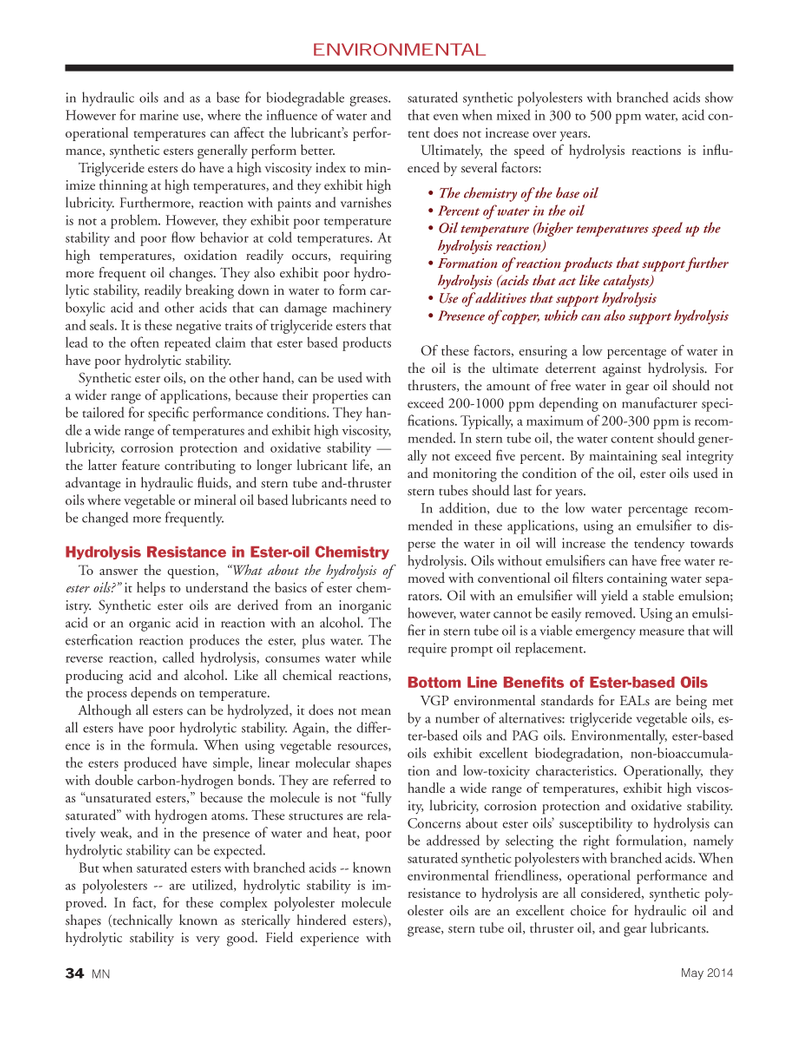
Page 34: of Marine News Magazine (May 2014)
Offshore Annual
Read this page in Pdf, Flash or Html5 edition of May 2014 Marine News Magazine
ENVIRONMENTAL in hydraulic oils and as a base for biodegradable greases.
However for marine use, where the infl uence of water and operational temperatures can affect the lubricant’s perfor- mance, synthetic esters generally perform better.
Triglyceride esters do have a high viscosity index to min- imize thinning at high temperatures, and they exhibit high lubricity. Furthermore, reaction with paints and varnishes is not a problem. However, they exhibit poor temperature stability and poor fl ow behavior at cold temperatures. At high temperatures, oxidation readily occurs, requiring more frequent oil changes. They also exhibit poor hydro- lytic stability, readily breaking down in water to form car- boxylic acid and other acids that can damage machinery and seals. It is these negative traits of triglyceride esters that lead to the often repeated claim that ester based products have poor hydrolytic stability.
Synthetic ester oils, on the other hand, can be used with a wider range of applications, because their properties can be tailored for specifi c performance conditions. They han- dle a wide range of temperatures and exhibit high viscosity, lubricity, corrosion protection and oxidative stability — the latter feature contributing to longer lubricant life, an advantage in hydraulic fl uids, and stern tube and-thruster oils where vegetable or mineral oil based lubricants need to be changed more frequently.
Hydrolysis Resistance in Ester-oil Chemistry
To answer the question, “What about the hydrolysis of ester oils?” it helps to understand the basics of ester chem- istry. Synthetic ester oils are derived from an inorganic acid or an organic acid in reaction with an alcohol. The esterfi cation reaction produces the ester, plus water. The reverse reaction, called hydrolysis, consumes water while producing acid and alcohol. Like all chemical reactions, the process depends on temperature.
Although all esters can be hydrolyzed, it does not mean all esters have poor hydrolytic stability. Again, the differ- ence is in the formula. When using vegetable resources, the esters produced have simple, linear molecular shapes with double carbon-hydrogen bonds. They are referred to as “unsaturated esters,” because the molecule is not “fully saturated” with hydrogen atoms. These structures are rela- tively weak, and in the presence of water and heat, poor hydrolytic stability can be expected.
But when saturated esters with branched acids -- known as polyolesters -- are utilized, hydrolytic stability is im- proved. In fact, for these complex polyolester molecule shapes (technically known as sterically hindered esters), hydrolytic stability is very good. Field experience with saturated synthetic polyolesters with branched acids show that even when mixed in 300 to 500 ppm water, acid con- tent does not increase over years.
Ultimately, the speed of hydrolysis reactions is infl u- enced by several factors: The chemistry of the base oil Percent of water in the oil Oil temperature (higher temperatures speed up the hydrolysis reaction) Formation of reaction products that support further hydrolysis (acids that act like catalysts) Use of additives that support hydrolysis Presence of copper, which can also support hydrolysis
Of these factors, ensuring a low percentage of water in the oil is the ultimate deterrent against hydrolysis. For thrusters, the amount of free water in gear oil should not exceed 200-1000 ppm depending on manufacturer speci- fi cations. Typically, a maximum of 200-300 ppm is recom- mended. In stern tube oil, the water content should gener- ally not exceed fi ve percent. By maintaining seal integrity and monitoring the condition of the oil, ester oils used in stern tubes should last for years.
In addition, due to the low water percentage recom- mended in these applications, using an emulsifi er to dis- perse the water in oil will increase the tendency towards hydrolysis. Oils without emulsifi ers can have free water re- moved with conventional oil fi lters containing water sepa- rators. Oil with an emulsifi er will yield a stable emulsion; however, water cannot be easily removed. Using an emulsi- fi er in stern tube oil is a viable emergency measure that will require prompt oil replacement.
Bottom Line Benefi ts of Ester-based Oils
VGP environmental standards for EALs are being met by a number of alternatives: triglyceride vegetable oils, es- ter-based oils and PAG oils. Environmentally, ester-based oils exhibit excellent biodegradation, non-bioaccumula- tion and low-toxicity characteristics. Operationally, they handle a wide range of temperatures, exhibit high viscos- ity, lubricity, corrosion protection and oxidative stability.
Concerns about ester oils’ susceptibility to hydrolysis can be addressed by selecting the right formulation, namely saturated synthetic polyolesters with branched acids. When environmental friendliness, operational performance and resistance to hydrolysis are all considered, synthetic poly- olester oils are an excellent choice for hydraulic oil and grease, stern tube oil, thruster oil, and gear lubricants.
May 2014 34 MN
MN May14 Layout 32-49.indd 34 4/21/2014 10:30:06 AM

 33
33

 35
35
